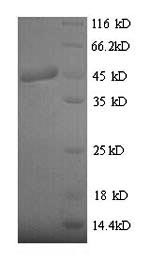The production of this Recombinant C. botulinum botB protein started with the botB gene synthesis. And then using recombinant DNA technology, the botB gene was inserted into an expression vector so that we could get the recombinant express plasmid of botB. Transform the plasmid into the cells of Yeast, culture the cells and we could get the desired Recombinant C. botulinum botB protein. But the work was not completed, protein purification and a strict QC system were performed in the last step. The purity is 90%+ determined by SDS-PAGE.
botB is a gene providing an instruction of making a protein named botulinum neurotoxin type B (BoNT/B) in clostridium botulinum. The protein encoded by this gene is also known as bontoxilysin-B and belongs to peptidase M27 family. This protein can be cleaved into two chains, including botulinum neurotoxin B light chain (LC) and botulinum neurotoxin B heavy chain (HC). It mainly targets motor nerve terminals and block neurotransmitter release, resulting in muscle paralysis.






